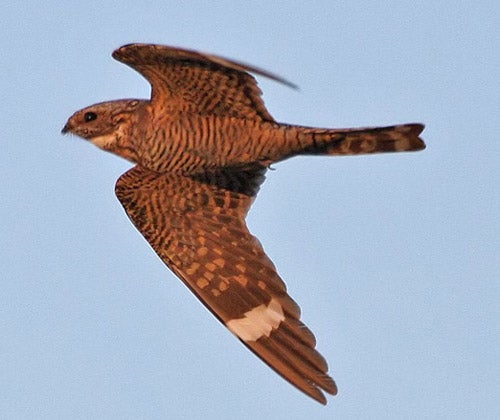SCIENTIFIC NAME:
Chordeiles acutipennis
STATUS:
Accidental.
DESCRIPTION:
Lesser nighthawks belong to a group of birds commonly known as Goatsuckers in Order Caprimulgiformes and Family Caprimulgidae. Lesser nighthawks look similar to common nighthawks except for their slightly less forked tail, more buffy coloration, and slightly smaller size. They are mostly dark in color with brown and white patterning on the breast and head. The upper parts consist of gray and white patterning. Wings are dark in color with a conspicuous pale patch 2/3 of the way from the bend of the wing. Their tails are dark with white barring. Lesser nighthawks are sexually dimorphic. The male differs from the female by having a white throat as compared to the buff throat and buff spots on the inner parts of wings of females. These birds have an overall length of eight to nine inches and have an extremely short bill approximately ¼-inch in length. Their wingspan is approximately 21 inches. Vocalizations of these birds have been described as a low toad-like trill making them difficult to locate.
DISTRIBUTION:
Lesser nighthawks are Neotropical migrants, with populations in South and North America. In the United States, their range includes smaller populations in parts of California and Nevada, with larger populations found in southern New Mexico, Arizona, and Texas. Lesser nighthawks do not typically occur in Alabama, but have been found as a vagrant along the Gulf Coast as far east as Florida.
HABITAT:
Lesser nighthawks commonly are found in large open brushlands or desert environments in low arid regions. They seem to prefer naturally open lands as opposed to areas that are open due to some type of disturbance. They like to inhabit relatively flat lands.
FEEDING HABITS:
Lesser nighthawks feed primarily on flying insects they catch on the wing. These insects usually are small and include winged ants, mosquitoes, beetles, moths, and grasshoppers. Lesser nighthawks forage mainly at dawn and dusk, but occasionally hunt at night during times of full moons or around lights. They prefer hunting near trees and brush found along streams and ponds.
LIFE HISTORY AND ECOLOGY:
Lesser nighthawks are nocturnal birds that roost during the day on the ground or on low branches. They breed in early spring to late summer, usually nesting in May and June. Brooding usually occurs on bare ground, but sometimes will occur on raised locations such as stumps, boulders, and flat roofs. One crucial element that influences selection of brooding sites is its seclusion from human disturbances. Females typically lay an average of two eggs per clutch. The two eggs are laid directly onto a bare area with no nest being constructed. These two speckled eggs will be incubated mainly by females for eighteen to twenty days. Once hatched, young are cared for primarily by females until they fledge at twenty days of age. Adults that get flushed from nests are known to sometimes attempt to use a distraction technique involving an aerial attack. At this time they will flush when an intruder approaches within a few meters of their nest and perform a low circling flight with accentuated wing beats. Likewise, young birds occasionally show a defensive display by opening their mouths and spreading their wings at intruders before fleeing.
REFERENCES:
Lesser nighthawk. Animal Diversity Web. University of Michigan Museum of Zoology https://animaldiversity.org/accounts/Chordeiles_acutipennis/
Lesser nighthawk identification tips. United States Geological Survey. https://www.mbr-pwrc.usgs.gov/id/framlst/framlst.shtml
Lesser nighthawk. IUCN Red List of Threatened Species https://www.iucnredlist.org/species/22689711/93243940
>Lesser nighthawk. Wikipedia – The Free Encyclopedia http://en.wikipedia.org/wiki/Lesser_Nighthawk
Sibley, D. A. 2003. The Sibley Field Guide to Birds of Eastern North America. Chanticleer Press, Inc, New York. 232 pp.
Author:
Justin Brock, Wildlife Biologist, Division of Wildlife and Freshwater Fisheries






